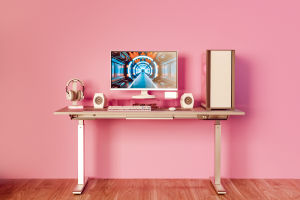In today's hectic life, having a private space to call your own is so important, especially as modern families tend to live in smaller apartments. With limited space, family members can sometimes disturb each other, making it difficult to focus.
That's when a study room becomes essential. It offers a quiet, undisturbed space for relaxation or work, helping us recharge or concentrate without interruptions.
As times change, the role of a study room has also evolved. It's no longer just a place to read or work; it's becoming a multi-functional space in many homes. When designing such a space, it's crucial to understand your needs to avoid mistakes in design that may lead to discomfort. Let's explore the different types of study rooms, popular partitioning methods, decoration tips, and color suggestions, as well as practical examples to help you create your own perfect space.
Understanding Your Study Room Needs
The study room, traditionally a quiet space, is now used in various ways depending on the needs of the household. Before starting the design process, it's important to first determine what you need the space for. This helps in choosing the right type of study room layout. We can break down the common study room needs into three categories: office use, multi-functional spaces, and bedroom-study combinations.
Office Use Study Room
An office study room is more than just for people working from home. It's a space for anyone who needs a quiet and focused environment for work or study. The key to designing this type of room is minimizing distractions. We need to block out noise and visuals from family members or other activities in the house.
For this, a well-defined, separate space is essential. It's best to use soundproofing doors and windows, and if the surroundings are noisy, consider using curtains to block out excess sound. If space allows, avoid sliding doors and opt for regular hinged doors to ensure better sound isolation. A soundproof study room works perfectly for home offices, studios, or exam preparation spaces.
Multi-Functional Study Room
A multi-functional study room is often found in smaller apartments. These spaces are typically open or semi-open, where the user doesn't require complete silence or intense focus but rather a space to relax or unwind. These rooms are often integrated with public spaces like living or dining rooms.
You can partition a multi-functional study room with bookshelves, screens, sliding doors, or half-walls to retain a sense of openness. This setup is ideal for families with children, allowing parents to relax while keeping an eye on their kids. It can also serve as a casual space to entertain guests, making it a versatile addition to any modern home.
Bedroom-Study Combination
Combining a bedroom and study room is common in smaller homes, providing both privacy and functionality. This setup is perfect for when a child needs their own space, and a study desk is placed in their bedroom or in a guest room that isn't frequently used.
The key to this design is to separate relaxation from focus areas. The desk and bed should be positioned so that you don't see the bed when sitting at the desk and vice versa. If the layout doesn't achieve this naturally, consider using furniture or curtains to partition the space effectively.
Choosing the Right Partition for Your Study Room
There are three primary partition types for study rooms: closed-off rooms, open spaces, and glass-enclosed rooms. Each option has its pros and cons, and the choice depends on your needs and budget.
Closed-Off Study Room
A closed-off study room is a fully separated space that offers the highest privacy and minimal distractions. This type of design works best if you have an extra room to spare, as it's the most cost-effective approach. However, if you don't have an extra room, creating a closed-off study using lightweight partitions may raise costs and reduce space, which is something to consider, especially in smaller homes where the added walls could feel cramped.
Open Study Room
Open study rooms are great for small apartments. They can be separated with half-walls, partitions, or large furniture, making them ideal for homes with a +1 room design or combined bedroom-study spaces. These rooms provide flexibility, though they do lack soundproofing. They work well in households where family members can avoid disturbing each other, but if noise is an issue, you may want to reconsider this option.
Glass-Enclosed Study Room
A glass-enclosed study room is similar to a closed-off room but with a lighter, more transparent feel. While not as soundproof as fully enclosed rooms, they offer significant noise reduction compared to open spaces. Adding curtains or smart glass to adjust transparency helps create a sense of privacy. However, it's important to consider that glass requires regular cleaning, and noise-sensitive people may find it less effective.
Decorating and Designing Your Study Room
Once you've chosen the right partition and layout for your study room, it's time to focus on decoration. The main elements in the room are desks, chairs, storage units, lighting, and overall flow.
Desk and Chair Size
Choosing the right desk and chair is critical for comfort during long work or study sessions. Most desks are around 70cm in height, which works for people of average height (around 5'7"). If you are shorter or taller, make sure to test the desk before buying to ensure that you can rest your elbows comfortably. The desk should also be at least 120cm wide to accommodate books or computers comfortably.
Bookshelves and Storage Furniture
While a wall of bookshelves might seem appealing, be mindful of the weight and storage capacity. Books can add up quickly, and shelves should be strong enough to hold them. Additionally, since Taiwan is in an earthquake zone, make sure your bookshelves are anchored securely to the wall for safety. Consider multi-functional furniture for additional storage space, such as chairs with hidden storage or extendable desk surfaces.
Lighting and Workflow
Good lighting is key for a productive study room. If the natural light is insufficient, use artificial lighting to make sure the space is bright enough. Pay attention to the layout of furniture to ensure a smooth workflow, especially if the room is used for work that requires filing and organizing papers.
Color Suggestions
The colors you choose for your study room can influence your mood. Lighter, warm colors create a relaxed environment, while cooler colors like blue can help improve concentration and focus.
Conclusion
We hope these tips have helped you envision your perfect study room! Whether you're working from home, studying, or simply relaxing, the design and layout of your study room should match your needs. Take your time to plan the space carefully, and you'll create a comfortable, functional area that's uniquely yours. Let us know how you've designed your study space—share your ideas with us, Lykkers!


